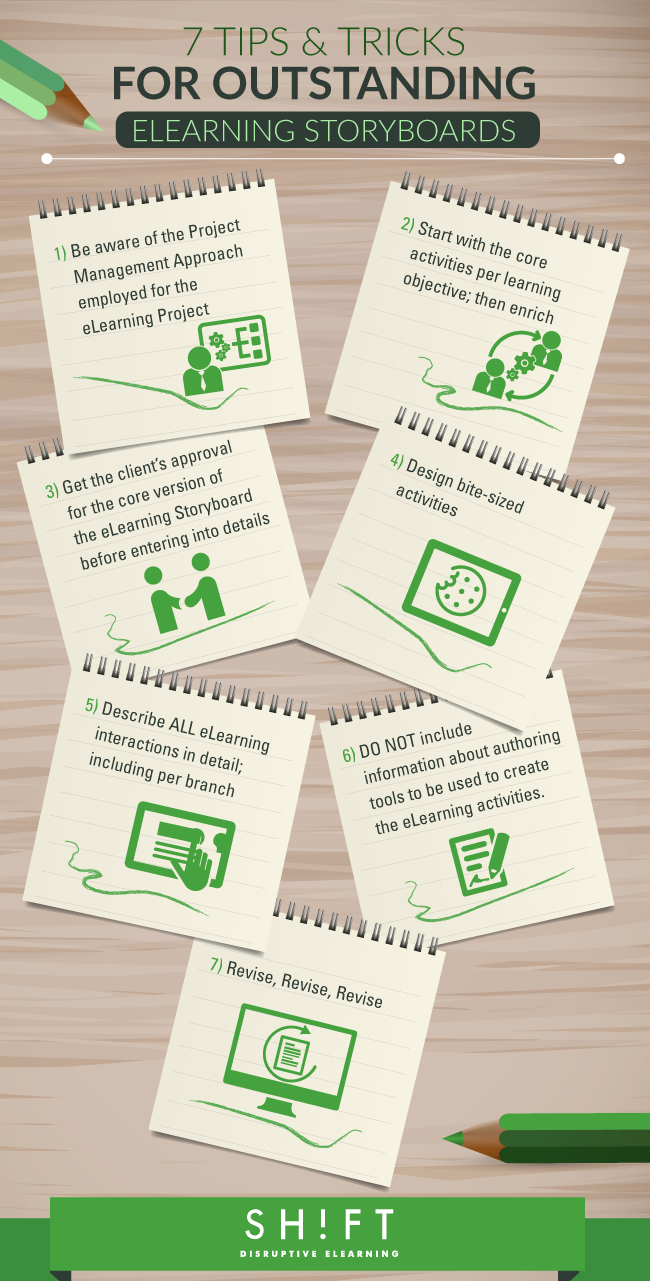Developing an eLearning storyboard is one thing, but turning it into a practical guide for anyone involved in the eLearning project is of utmost importance. In this article, I will give you 7 tips & tricks you can use to design outstanding eLearning storyboards.

1) Be aware of the project management approach employed for the eLearning project.
Keeping strict deadlines is essential for the success of the eLearning Project, and since you, as an Instructional Designer, are the first person involved in the process, as you need to provide the rest of the eLearning team with a plan on how to work, there is always time pressure involved in your job. You are expected to hand in the eLearning storyboard the soonest possible without losing in quality. How to plan your work, therefore, greatly depends on the Project Management approach employed for the eLearning project. With an ADDIE approach, my suggestion is to start with the first unit, and hand it in as soon as it is completed; you can make revisions during the Evaluation stage of the ADDIE model, if necessary. However, if an AGILE Project Management approach is employed, which is actually the latest trend, your approach should be to work many different units of your eLearning storyboard in parallel.
2) Start with the core activities per learning objective; then enrich.
Whatever the eLearning Project Management approach is, I strongly recommend always starting with the minimum requirements. These are the core activities per learning objective, either for the specific eLearning module you deliver or for the entire eLearning course. My suggestion is that your eLearning Development Team should start developing the core structure of the entire course, with the minimum possible requirements in terms of the information to be presented and learning objectives to be covered, and once this core structure is finished, to start enriching each unit with supplementary and optional activities.
The benefit of this approach is that it accelerates the time that you can present a first draft of the eLearning course to the client, before entering into further elaboration of the information presented with costly multimedia elements, such as eLearning video production, professional voice over, development of simulations etc. Although it’s always nice to have, let’s say, three examples per learning objective, it is necessary first to create at least one, and if time and budget permits, once the eLearning Project Manager has the core information of the eLearning course well-structured, then they can decide how to allocate the rest of the client’s budget to further elaborate the eLearning course by asking you to add more interactivity and multimedia elements to the next version of the eLearning storyboard.
3) Get the client’s approval for the core version of the eLearning Storyboard before entering into details.
Although you may be tempted to show your clients what your company can do for them, resist the temptation, since it’s not the right time to do so. There is no doubt that the sales representatives of your company have already done their job properly with the client. Don’t forget, that it’s a common practice for many clients to sign the contract after they have approved the eLearning storyboard. Revising the eLearning storyboard with the client, therefore, is an integral part of this initial phase. Getting the client’s approval for the core version at this stage, guarantees that the eLearning course you are going to develop is exactly what the client is looking for.
4) Design bite-sized activities.
Micro-learning is here to stay as it meets the needs of modern learners. Following a micro-learning approach in your eLearning storyboard also has additional benefits for the eLearning project, as it can significantly reduce production costs, as files to be designed are smaller in size. In addition, it is easier to make changes during the revision stage or to keep these files updated later on, in case an update of the eLearning course material is needed. Last, but certainly no least, bite-sized activities are reusable, with minor changes, even for other eLearning courses of similar subject matter.
5) Describe ALL eLearning interactions in detail; including per branch.
Be as detailed as possible when describing eLearning interactions, especially in case branching scenarios or other types of eLearning activities with multiple options are involved. Keep thinking that your eLearning storyboard should function as a blueprint to all eLearning developers. Their job is to develop exactly what you have described in the eLearning storyboard and not to improvise. Your eLearning storyboard should, therefore, leave no room for misinterpretations; you need to provide them with analytical descriptions about the exact text, hypertext, hotspots and mouse over text to appear on screen, the exact location of each hotspot or hyperlink on screen and where each of these elements leads to, the exact eLearning content to appear per option, the exact feedback the user will receive per selection, the script and voice over instructions per screen, etc.
6) DO NOT include information about authoring tools to be used to create the eLearning activities.
Stay focused on your job. eLearning storyboards are not about eLearning authoring tools. They describe what to be done, not which tool to be used. Of course, as an Instructional Designer, the more you know about the available authoring tools in the market, and their functions, the more ideas you can get about possible interactive elements you may add to your eLearning course.
7) Revise, Revise, Revise.
You have finished your eLearning storyboard and now you want to take a final look into its details. But how you can be sure that your eLearning storyboard is really over before handing it in to the eLearning Project Manager? Especially, if it the first one you create, you may feel that there is always something missing; a “little” extra that you could have added that would make the difference. From practical experience, I can say that eLearning storyboards never really come to an end. Never forget that the eLearning Storyboards development process is all about revisions. As this is the first step in the eLearning development process, do not hesitate to revise them again and again, until your feel that they meet not only the learning objectives of the eLearning course, but also the qualitative standards you have set as an eLearning professional.
To answer the question, you know that you have finished your eLearning storyboard when there is at least one way to present, one way to practice and one way to assess each one of the learning objectives you have set for the course. This will be your core eLearning storyboard; you may call it Draft1, version1, v1 or whatever you feel like, but this draft is over. As a matter of fact, as soon as you hand in this first version to the eLearning Project Manager in order for the development phase to begin, expect that, most probably, it will be returned back to you for further revisions, even from the very first Sprint Planning Meeting of the eLearning team! Then you may further enrich the eLearning content by adding more visual elements and user opportunities for interaction with the eLearning course.
In practice, it is not uncommon, many eLearning professionals to skip the storyboard phase, as developing a successful eLearning storyboard is really a time-consuming task. However, the more complicated the eLearning project and the largest the eLearning team, the greatest the necessity for an eLearning storyboard. If you are new to storyboards and you don’t know how to start, read the article A Practical Guide On How To Start With eLearning Storyboards to discover all the steps involved in developing an effective eLearning storyboard. Then you can use the above tips and tricks to polish it, until it becomes outstanding.
About the author:
Marisa Keramidá (M.Ed) is an experienced Instructional Designer for eLearning. She has worked for several international companies as a Corporate Trainer, Training Content Developer and eLearning Specialist.








